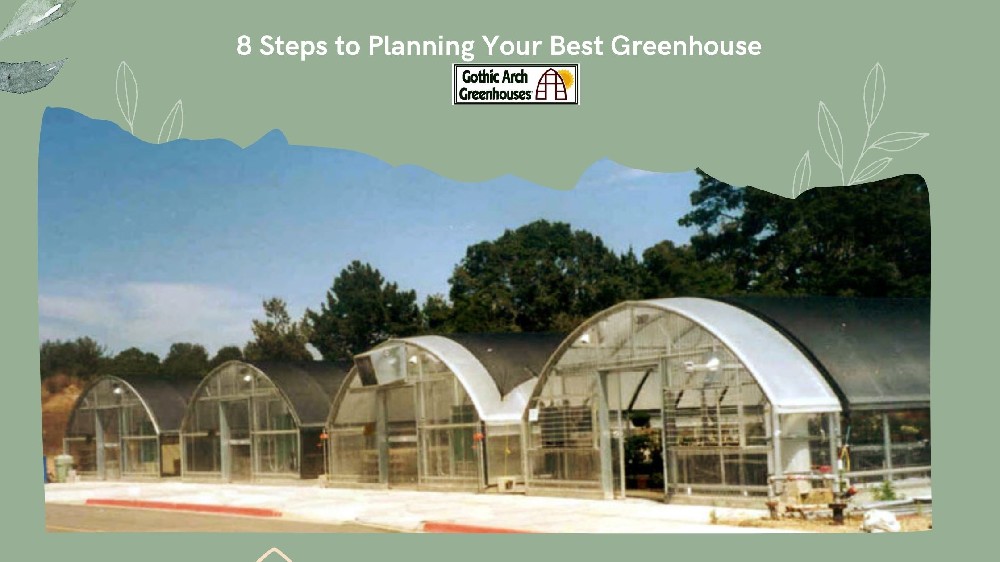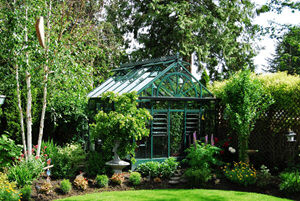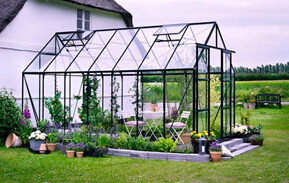8 Steps to Planning Your Best Greenhouse

Understanding how to plan and build a greenhouse can be a rewarding challenge for garden enthusiasts looking to extend growing seasons. Here, We will guide you through eight essential steps to create an optimal environment for your plants, helping you achieve a vibrant and productive garden all year round.
The best greenhouses are beautiful, functional, and planned with an eye toward the future. Whether you grow for pleasure or profit, these tips can help you get the most from your greenhouse and your investment! Here's how to plan for your best greenhouse! A well-planned greenhouse extends the growing season, providing a sanctuary for gardeners and a stable plant environment. Planning is crucial to avoid common pitfalls and ensure your greenhouse is functional and cost-effective.
1. Choose the Best Greenhouse Location
Many people place their greenhouse wherever they have the space and easy access to utilities. Others may plan a site that has the best light and exposure. Several additional considerations exist when planning around the surrounding structures and landscape elements. Trees and shrubbery will grow, affecting light, but you also want to plan for future beds to transplant seedlings and possible additions to buildings. You may even add to your greenhouse, barn, or shade house later!
The location of your greenhouse significantly affects its efficiency and effectiveness. Consider factors such as sunlight exposure, wind protection, and proximity to water sources. An ideal location is on the south or southeast side of your property to capture early-day sunlight. Avoid areas shaded by buildings or trees, especially during the peak sunlight hours of 10 AM to 4 PM

2. Designing Your Greenhouse
Greenhouses don't have to be generic lookalikes or simple working structures. They can be custom-designed to reflect your home or business's style and taste. Custom knee-walls to match your architecture, roof peaks, finials, and more can add style and value to your property. Let Gothic Arch help you design the perfect greenhouse to suit your style and landscape.
Deciding on the design of your greenhouse is critical. Consider the type of greenhouse that best fits your needs—a lean-to, a freestanding structure, or a more elaborate geodesic dome. Each type offers different benefits and challenges. Materials are also necessary; glass is traditional, but polycarbonate panels are more durable and provide better insulation.
3. Connect greenhouse buildings
Beautiful connections can be made between your greenhouse and home, garden center and retail store, farm market and production area—limitless possibilities. Use a gazebo, a porch, a shade house, or lean-to to create vestibules, sitting areas, potting sheds, or multi-use spaces that protect you and your plants from inclement weather. Gothic Arch can provide everything you need to create a blended-use growing area that is your perfect fit.

In retail use, "A rainy weekend at the end of spring can drop sales up to 80 percent," according to horticulture expert Chuck Sierke. "If you can cover more area with canopies and awnings, that is the biggest potential for up-sales even in inclement weather."
4. Install the Right Greenhouse Doors
Entry and exit doors should be wide and easy to manipulate. When hands are full with tools, supplies, and plants, an easy-open door that can accommodate carts, wheelbarrows, and equipment will ease your day. Gothic Arch offers single and double swinging doors, sliding doors, and all widths of roll-up doors. You can place them in end walls, sidewalls, or entry vestibules, ensuring the desired look with the needed access.
5. Open Up Interior Greenhouse Space
An easy way to create an open feel is to reduce the number of columns, using beams instead. Fewer posts increase growing space and allow for better bench layouts. Planning hose bibs and utilities to keep walkways open and equipment needs managed can help maximize your layout and available space.
Maximizing space inside your greenhouse allows for more plant variety and greater yield. Utilize vertical space with hanging planters and shelves. Planning your layout to include walking and working spaces will also improve accessibility and maintenance.
6. Choose Durable Covering Materials
Polycarbonate versus polyethylene gives a long life and a more permanent look. It lasts 20-plus years rather than four or five, though it is a more significant initial investment. Glass improves further, with excellent light transmission and longer life. Rigid coverings take far less maintenance than films and have excellent R-value. Gothic Arch Greenhouses offers many different thicknesses and covering properties to help growers get the best energy efficiency for their budget.
7. Consider Greenhouse Climate Control
Many growers prefer more natural ventilation than fans, utilizing open-roof designs, sliding doors, or roll-up curtain walls. However, insects and pests are more challenging to keep at bay with open designs, and humidity extremes can also be more challenging to manage. A greenhouse professional can help you to decide what is right for you. In many cases, custom insect screening for your roof vents, ridge, or intake shutters can be added to your greenhouse design, helping increase your airflow while limiting unwanted pests.
Controlling the climate inside your greenhouse is essential for plant health. Temperature regulation can be achieved through ventilation, heating, and shading. Misting systems can maintain proper humidity levels, which helps prevent plant diseases.
8. Rethink Greenhouse Irrigation
There are many options for water management besides traditional overhead watering systems. A sub-irrigation system with an automated pump and tank can flush out salt buildup and allow better water absorption. Hydroponic systems also root-feed water and nutrients to plants, which results in losing water only due to evaporation, saves labor, and makes for a less damp environment. Water conservation, efficiency, and plant health are all considerations the Gothic Arch Greenhouses team can help you navigate to find your ideal watering solution.
Efficient watering systems are crucial for a successful greenhouse. Drip irrigation and soaker hoses ensure plants receive the necessary water without waste. Automating your watering system can save time and help maintain a consistent moisture level.

Essential Accessories
Certain accessories are vital for a productive greenhouse. Thermometers, hygrometers, and soil pH testers help monitor environmental conditions. Consider DIY options and commercial solutions to find what best meets your needs.
Maintaining Your Greenhouse
Regular maintenance is key to a greenhouse’s longevity. Check structures and coverings for damage, keep vents and gutters clear, and monitor for pests. Early detection and management of issues will keep your greenhouse thriving.
Planning and maintaining a greenhouse requires careful thought and attention to detail. By following these eight steps, you can ensure that your greenhouse is a productive and enjoyable addition to your gardening activities.
FAQs
How much does a typical greenhouse cost?
The cost of building a greenhouse can vary widely, depending on size, materials, and whether you choose a DIY project or a commercial kit.
What is the best time of year to build a greenhouse?
Early spring or late summer are ideal, as they allow you to prepare for the upcoming growing season.
Can I build a greenhouse on a budget?
Yes, there are many cost-effective options and designs that can fit smaller budgets without sacrificing quality.
How do I choose the right plants for my greenhouse?
Select plants matching your greenhouse’s climate conditions and personal maintenance preferences.
What are the long-term benefits of owning a greenhouse?
A greenhouse offers year-round gardening, increased plant variety, and the joy of gardening in any weather condition.
Greenhouse growers, large and small, can benefit from considering these 8 things when planning or refurbishing their growing space. Planning not just for today but for tomorrow's harvest can help you choose the best greenhouse for how you grow and what your goals are. Gothic Arch Greenhouses' 75+ years of experience can help you plan, design, and grow, whether you need a simple backyard greenhouse kit or a 1,000-acre commercial agriculture range. Reach out to our experts today!
